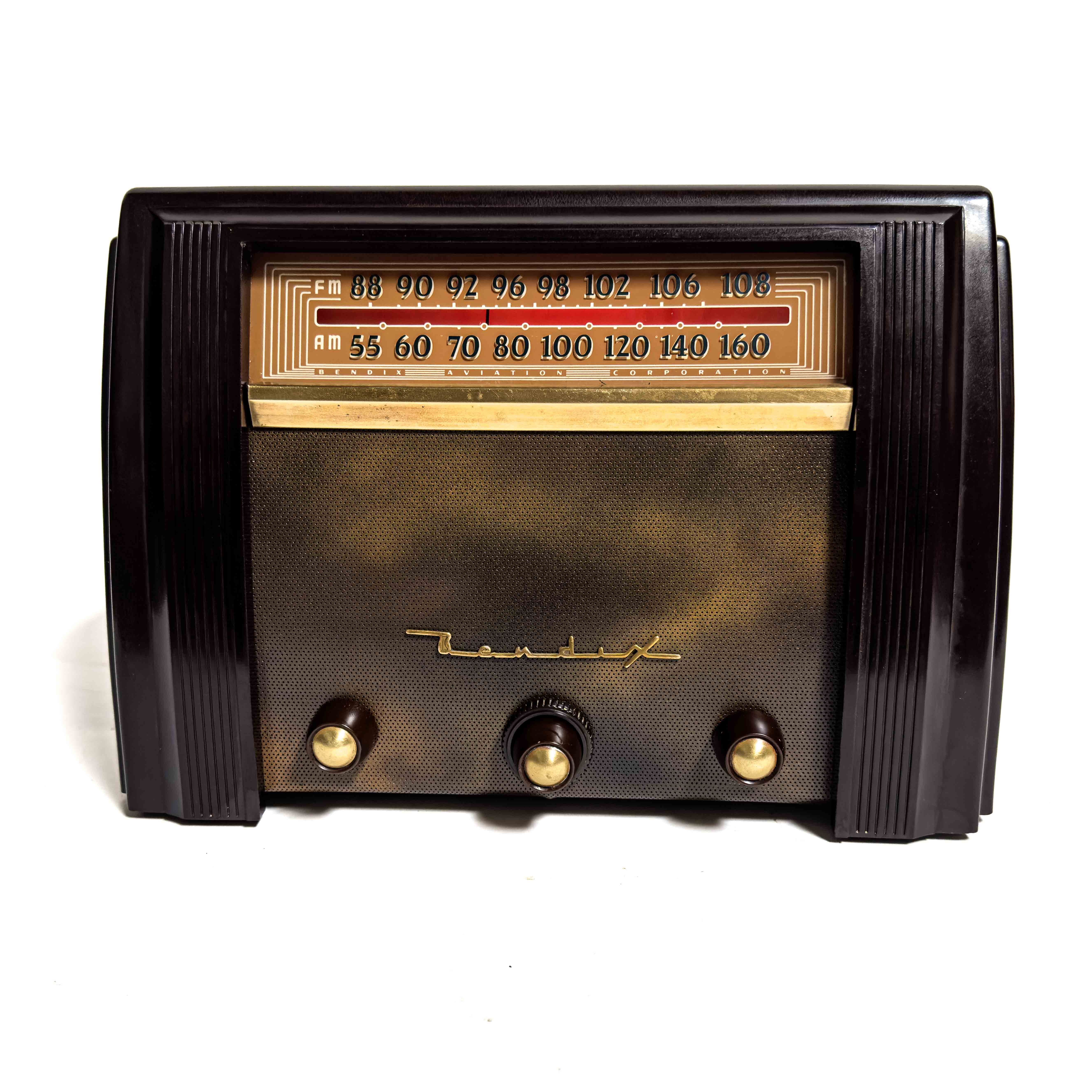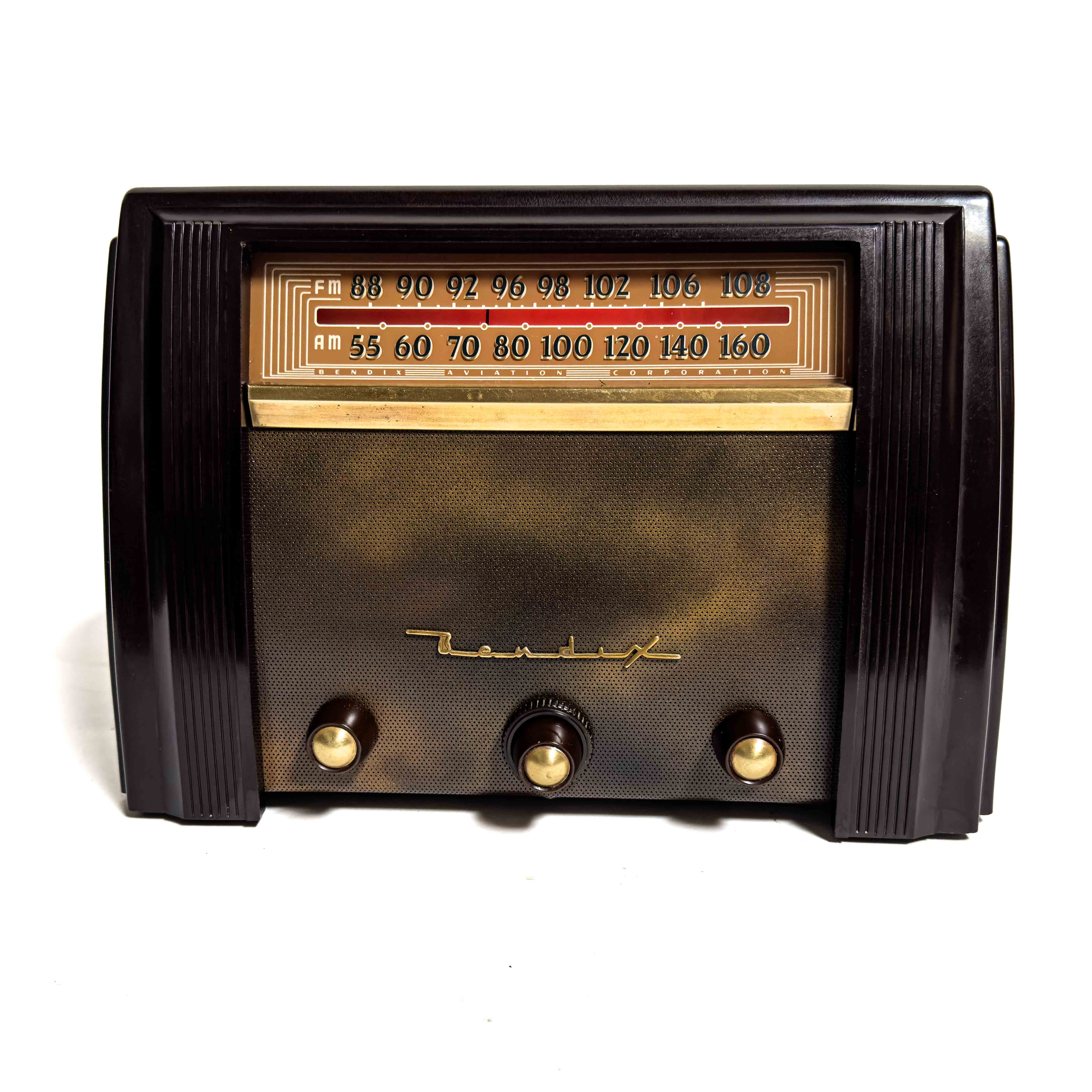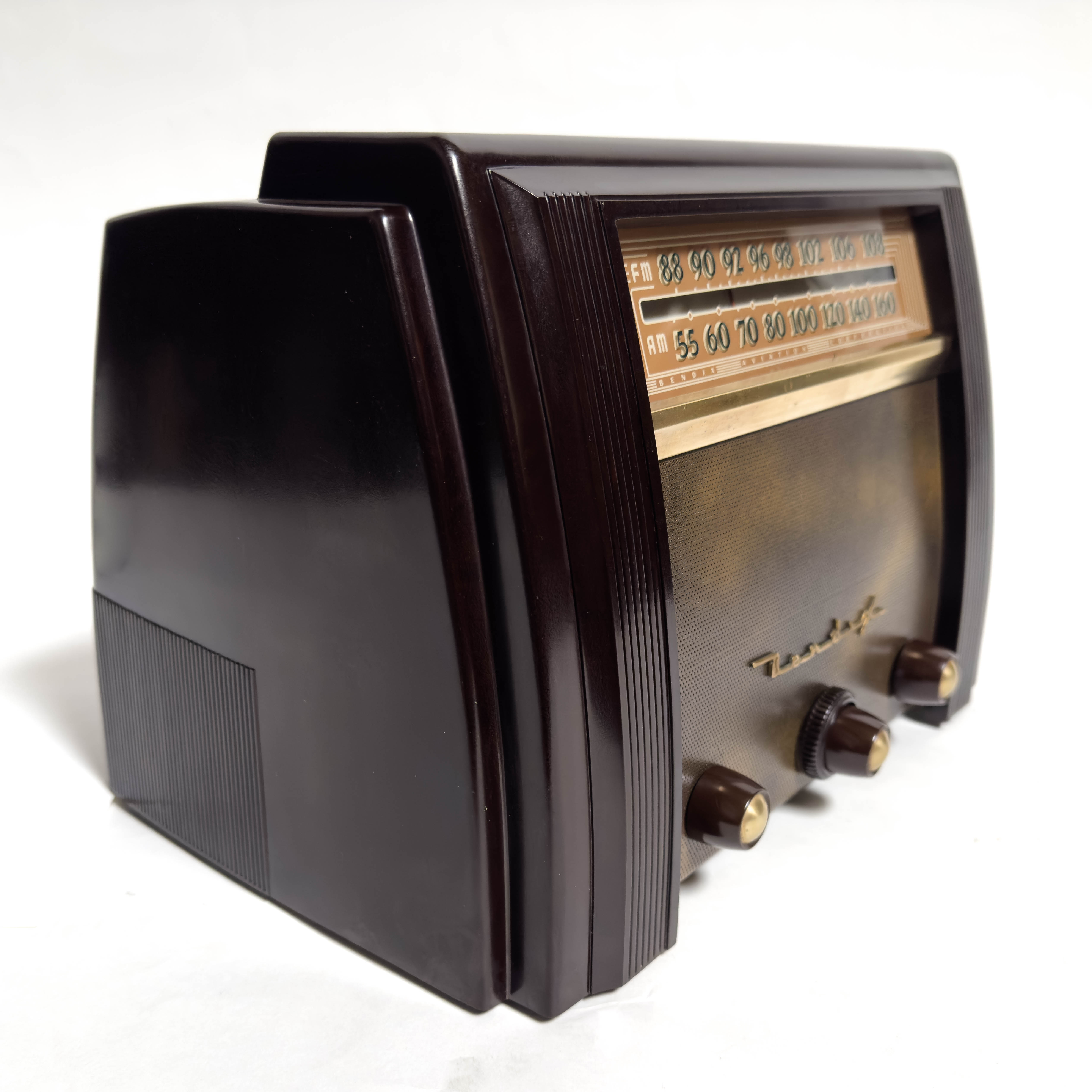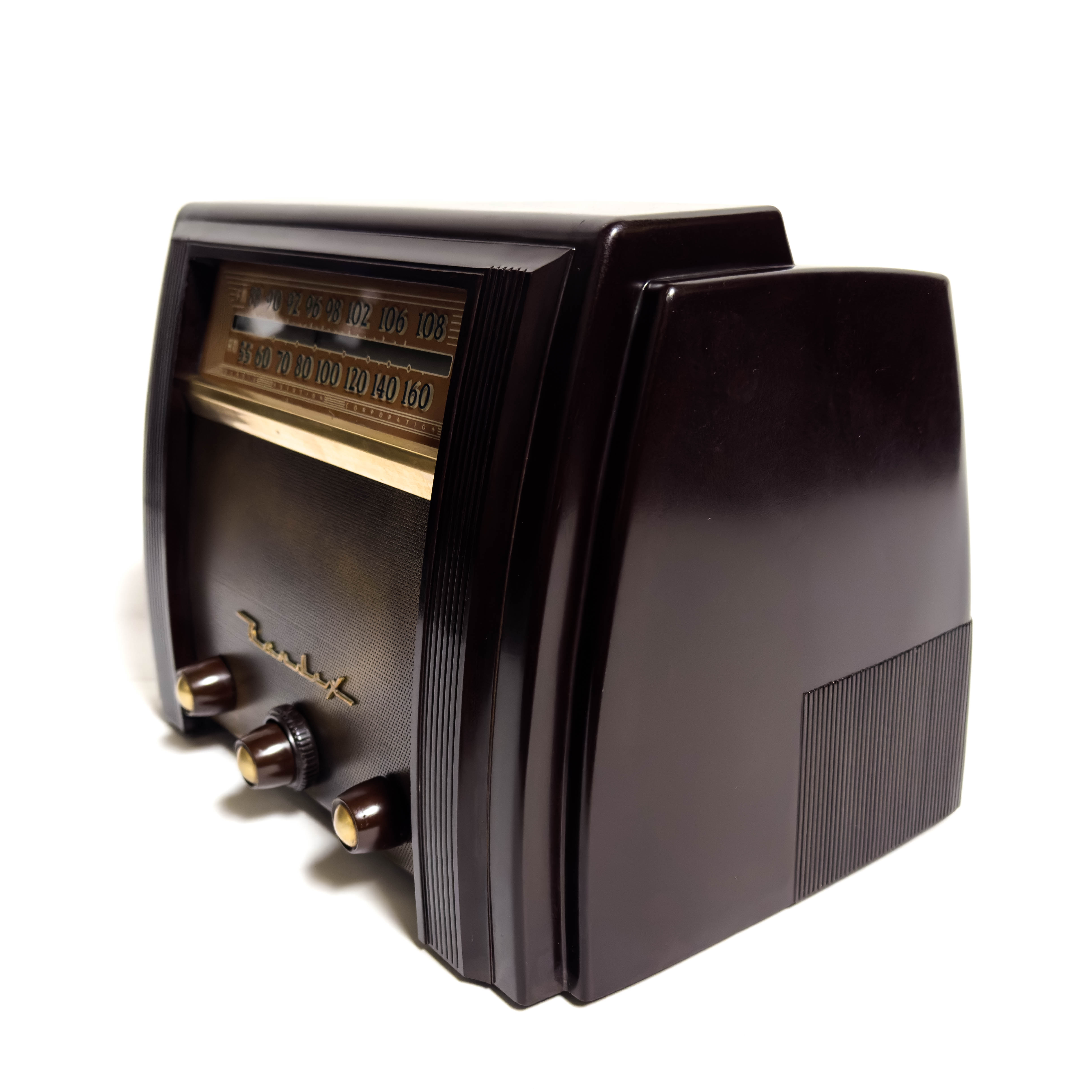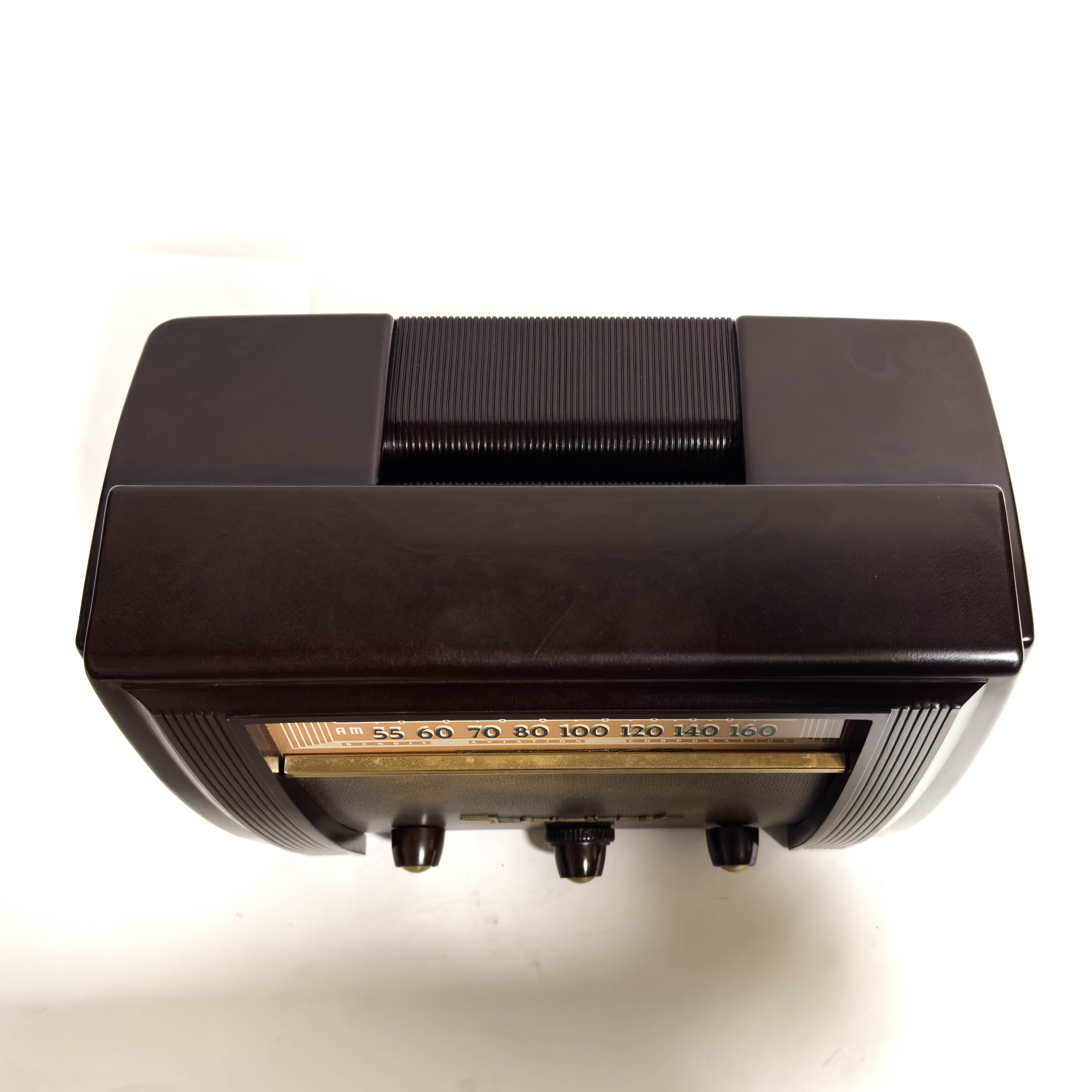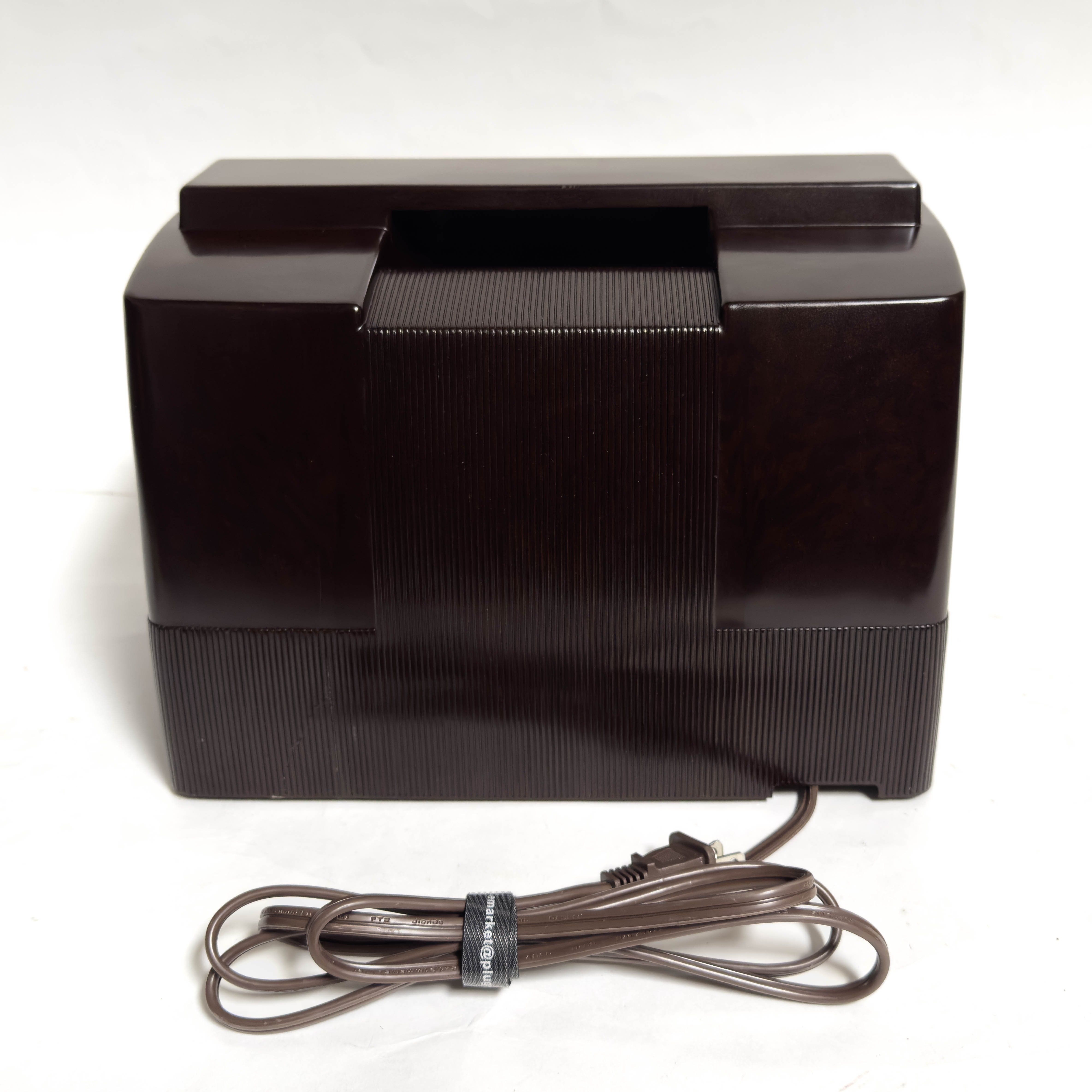- Collection
- >
- Bendix 75P6U Tabletop (1948)
Bendix 75P6U Tabletop (1948)
SKU:
$425.00
$425.00
Unavailable
per item
PRIVATE COLLECTION
The sculpted Art-Deco shape of this American-made beauty is a welcome departure from the typical boxy radio cabinets of the 1940’s. The chassis mounts on the underside of the cabinet shell, and there’s a convenient hollow cutout just under the top panel for venting and carrying. The Walnut Bakelite cabinet is beautifully swirled, and the metal grill is finished in a burl wood pattern. The slide rule dial is a sight to behold when it’s lit up by the large pilot bulb inside. Copper trim just under the dial and on each of the side knobs adds beautiful accenting to this AM/FM Model 75P6U from 1948. Knobs consist of Volume, a central Tuning knob with Tone control nested behind it, and the right-hand knob is for switching from AM to FM.
I restored this radio to a better than new condition while keeping it as original as possible. You will not see another in this authentic condition. This radio is now in my personal collection and not for sale
History - Vincent Bendix began his company with an idea for an automatic starter for automobiles in 1911. Bendix Corporation was renamed the Bendix Aviation Corporation in 1929 to signify a new direction for the company.
The Bendix Radio Corporation was founded in 1936 because of the company’s purchase of an interest in the Radio Research Company and subsequently, the purchase of the W. P. Hilliard Company, the Jenkins & Adair Corporation, Industrial Instruments, Inc., and the Radio Products Company of Dayton.
After acting as a subsidiary for several years, Bendix Radio became an operating division of Bendix Aviation. The division was established in 1937 to make radio transmitter/receivers for aircraft and other types of avionics. During the war Bendix manufactured about 75% of all avionics in US aircraft. During and after the war Bendix made radar equipment of various types.
Although there was an emphasis on home appliances such as radios, the companies involved were encouraged to find new radio technology applications. Bendix first manufactured domestic phonographs and radios for the retail market in the late 1940s. It also began producing car radios at the same time. Bendix successfully marketed radios in the late 1940s. Radio sales declined quickly in the 1950s as competition in the consumer market increased exponentially.
Cabinet – I cleaned and polished the Bakelite cabinet. It now displays with beautiful gloss, and has no nicks, cracks, scratches, or mars. The metal grill was repainted and sealed with semi-gloss lacquer.
Dial - The slide rule dial scale looks flawless with beautifully silk-screened graphics and numerals that take on a new appearance when the radio’s amber pilot light is on. I disassembled it cleaned it to remove the 70+ years of dust and debris.
Chassis - I went through the chassis replacing all the electrolytic and wax capacitors, checking, and replacing resistors and tubes where needed. It now gives excellent reception free of distortion across both AM and FM bands. I removed the dangerous selenium rectifier and installed a new power cord and solid-state rectifier for safety and longevity. I aligned the radio, and it plays well across the dial and both bands. Knobs are Bendix original, and all the original fasteners are present. The factory tube layout diagram is legible and intact on the bottom side. The radio is clean inside and out with no odors, and the six tubes are easily accessed with a simple screwdriver.
Speaker – The 4”x6” permanent magnet speaker was intact when we got it. I cleaned and reinforced it. It tests well across the audio spectrum and should last for many, many years.
Antenna - This model comes with a built-in AM loop antenna. Basic FM reception is achieved through a line coupling with the AC line cord. We disassembled, inspected, and cleaned the loop antenna and replaced any worn wires. I can receive well most of our AM and FM stations in the San Francisco Bay Area without any external antenna (see video demo). Better reception can be had with an external antenna connected to the underside terminals.
NOTE: I did not put a Bluetooth / Auxiliary input on this radio because it receives FM broadcast.
Year of Manufacture: 1948/1949
I restored this radio to a better than new condition while keeping it as original as possible. You will not see another in this authentic condition. This radio is now in my personal collection and not for sale
History - Vincent Bendix began his company with an idea for an automatic starter for automobiles in 1911. Bendix Corporation was renamed the Bendix Aviation Corporation in 1929 to signify a new direction for the company.
The Bendix Radio Corporation was founded in 1936 because of the company’s purchase of an interest in the Radio Research Company and subsequently, the purchase of the W. P. Hilliard Company, the Jenkins & Adair Corporation, Industrial Instruments, Inc., and the Radio Products Company of Dayton.
After acting as a subsidiary for several years, Bendix Radio became an operating division of Bendix Aviation. The division was established in 1937 to make radio transmitter/receivers for aircraft and other types of avionics. During the war Bendix manufactured about 75% of all avionics in US aircraft. During and after the war Bendix made radar equipment of various types.
Although there was an emphasis on home appliances such as radios, the companies involved were encouraged to find new radio technology applications. Bendix first manufactured domestic phonographs and radios for the retail market in the late 1940s. It also began producing car radios at the same time. Bendix successfully marketed radios in the late 1940s. Radio sales declined quickly in the 1950s as competition in the consumer market increased exponentially.
Cabinet – I cleaned and polished the Bakelite cabinet. It now displays with beautiful gloss, and has no nicks, cracks, scratches, or mars. The metal grill was repainted and sealed with semi-gloss lacquer.
Dial - The slide rule dial scale looks flawless with beautifully silk-screened graphics and numerals that take on a new appearance when the radio’s amber pilot light is on. I disassembled it cleaned it to remove the 70+ years of dust and debris.
Chassis - I went through the chassis replacing all the electrolytic and wax capacitors, checking, and replacing resistors and tubes where needed. It now gives excellent reception free of distortion across both AM and FM bands. I removed the dangerous selenium rectifier and installed a new power cord and solid-state rectifier for safety and longevity. I aligned the radio, and it plays well across the dial and both bands. Knobs are Bendix original, and all the original fasteners are present. The factory tube layout diagram is legible and intact on the bottom side. The radio is clean inside and out with no odors, and the six tubes are easily accessed with a simple screwdriver.
Speaker – The 4”x6” permanent magnet speaker was intact when we got it. I cleaned and reinforced it. It tests well across the audio spectrum and should last for many, many years.
Antenna - This model comes with a built-in AM loop antenna. Basic FM reception is achieved through a line coupling with the AC line cord. We disassembled, inspected, and cleaned the loop antenna and replaced any worn wires. I can receive well most of our AM and FM stations in the San Francisco Bay Area without any external antenna (see video demo). Better reception can be had with an external antenna connected to the underside terminals.
NOTE: I did not put a Bluetooth / Auxiliary input on this radio because it receives FM broadcast.
Year of Manufacture: 1948/1949
